Social capital in Scotland: report
Report examining social connections within Scottish communities and what can be done to make these communities stronger and more inclusive.
Executive summary
In this report, ‘social capital’ refers to the social connections that contribute to people’s quality of life, health, safety, economy and wellbeing in the neighbourhoods where they live. These social connections are a source of support through people’s lives, for instance, in education, workplaces, retirement and leisure.
Using a range of data and stories from people and places, this report examines neighbourhood and social relationships in more detail. This provides a deeper insight into the nature of communities in Scotland, and what can be done to make them stronger and more inclusive.
This report looks at four inter-related aspects of social capital:
- Social networks – The quality of friendships, relationships, and contacts; the help that people provide and receive from neighbours; and how connected and supported people perceive themselves to be.
- Community cohesion – The features of neighbourhoods and communities including safety, trust and kindness; the places and spaces for people to meet; and to meet people from different backgrounds.
- Social participation – The time given up to support local clubs, groups, organisations, or improve the local environment.
- Community empowerment – The control that people have, and feel they have, over their circumstances; their influence on local decision-making; and their actions to improve the local community.
How strong is social capital in Scotland, and how it is changing over time?
The most recent findings in the Scottish Household Survey (Fig 1) provide evidence of strong community connections, including supportive relationships with neighbours, positive ratings of neighbourhoods and high levels of volunteering.
The findings also show evidence that is of more concern. Twenty one percent of people said they experience loneliness regularly; and only twenty percent said they feel they have influence over local decisions. This means 4 out of 5 people feel a lack of influence over what happens in their community.
Fig 1. Latest data shows evidence of neighbourhood strengths but also higher levels of loneliness, and low levels of perceived influence. (Scottish Household Survey, 2018)
- 95% of people rate their neighbourhood as ‘good’ or ‘very good’.
- 83% of people said they live in a neighbourhood where people are kind to each other.
- Half of people (48%) said they take part in formal or informal volunteering.
- 1 in 5 people (21%) said they experienced loneliness in the last week
- 1 in 5 people (20%) said they have influence over local decisions that affect their neighbourhood.
How is it changing over time?
As well as examining current levels, this report also considers how social capital is changing over time and presents a statistical dashboard index - containing 18 variables within 4 social capital themes – to provide an indication of trends (Fig 2).[1] This index shows a picture of stability between 2013 and 2017, followed by a small (though statistically significant) decrease between 2017 and 2018.
The decrease is due to a lower proportion of people saying they would give, or expect to receive, help from their neighbours, as well as a reduction in levels of volunteering and a reduced level of perceived influence over local decisions.
Fig 2. The social capital index shows that there have been stable trends since 2013, but a slight reduction (-5%) between 2017 and 2018 surveys. (Scottish Household Survey, 2018).
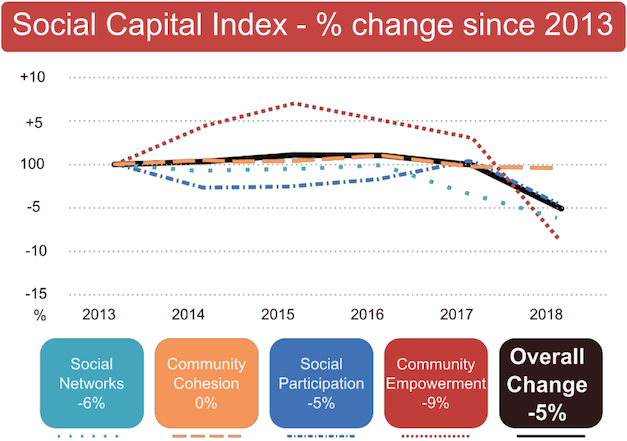
How is social capital distributed across social groups and geographies, and what groups and places have lower levels of social capital?
Although there are positive findings for the vast majority of people in Scotland overall, there are variations across different places and subgroups of the population.
For example, there are large variations between local authorities when people are asked about the qualities of their neighbourhoods, and their experience of loneliness ‘in the last week’ (Fig 3).
Fig 3. The highest and lowest three local authority areas on measures of social capital. There are large variations from the Scotland average across authorities. (Scottish Household Survey, 2018)
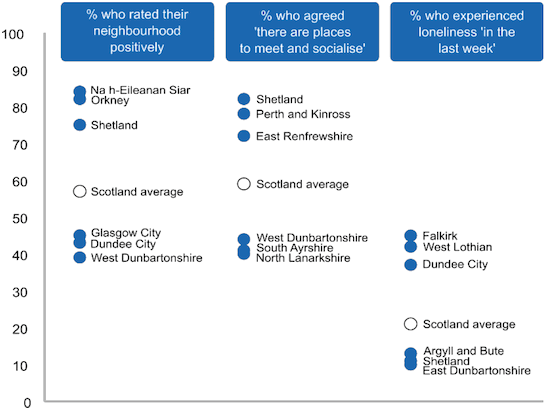
Social capital measures are lower in more deprived areas, where people are more likely to report feelings of loneliness, and less likely to rate their neighbourhood well and say they have places to interact.
People in more deprived areas (as measured by the Scottish Index of Multiple Deprivation – SIMD) are however only slightly less likely than people in less deprived areas to report weekly social interactions with friends, relatives, work colleagues and neighbours (Fig 4). This suggests factors other than the quantity of social interaction are involved in the higher reported levels of loneliness.
Fig 4. Social capital measures in the 20% most deprived areas (by SIMD) compared with people in the least deprived areas. People in the least deprived areas to experience loneliness, and also have lower neighbourhood ratings, but have similar levels of social interaction.
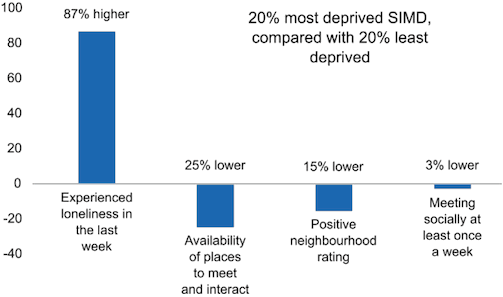
Social capital measures are generally higher than the Scotland average in rural locations and lower in urban locations (see Annex for tables).
As well as being related to immediate local circumstances, variations in social capital within and between geographical areas may be associated with the population composition of those areas (for example, concentrations of people within certain demographic characteristics or income levels) and the history and social context of the areas.
To provide another perspective, case study stories were collected to deepen the understanding of social capital. These stories help to convey the impact of broader economic change on communities, and their perceived effects on attitudes and expectations about social connections (see Fig 5) and the need for improved infrastructure and support.
Fig 5. (Excerpt from ‘James’s story’.)
“There was plenty of factories around. Then during the 80s it was as if a storm hit the community and all the big industries closed down. It was like a domino effect, one went down and then bang bang bang. The local community centres have been knocked down, schools and doctor surgeries have closed and you just take it as that is what happens here so people develop this kind of attitude of this is as good as it is going to get. There are groups of people who volunteer and who try to make spaces accessible for the community. They have raised money to get park benches and to put in goal posts so the kids can play football. People try to connect, to help each other but it can be hard at times.”
Personal factors
Measures of social capital vary across subgroups of the population based on personal characteristics such as gender, age, ethnicity, disability and employment status, and there is strong evidence that social connections are related to people’s personal circumstances and their life stage.
There are apparent differences between women and men in the survey.[2] Levels of social networking and positive neighbourhood relations are higher for women than men. In contrast, women are less likely to feel safe in their neighbourhood at night (74% of women compared to 91% of men (Fig 6)) and are more likely to have experienced loneliness ‘in the last week’ (24% of women compared to 19% of men).
Fig 6. Gender and safety, (Scottish Household Survey, 2017)
74% of women reported feeling safe at night in their neighbourhood compared to 91% of men.
Younger people (16-34) are slightly more likely to experience loneliness than the national average (24% compared to 21%) but are more likely to meet socially with friends, neighbours, relatives and work colleagues. People aged 65+ typically have higher levels of neighbour support, and are more likely to feel a sense of belonging to their neighbourhood.
There is a complex pattern between social interaction and loneliness (Fig. 7). Some groups within the population (including women, people in remote towns, and the youngest and oldest age groups) experience higher levels of loneliness and higher levels of social interaction.
Fig 7. Loneliness and isolation, group differences from the Scotland average. There is a complex pattern between social interaction and loneliness. In some circumstances loneliness may be more associated with isolation, and for other subgroups it may be associated with life course factors, or other inequalities.
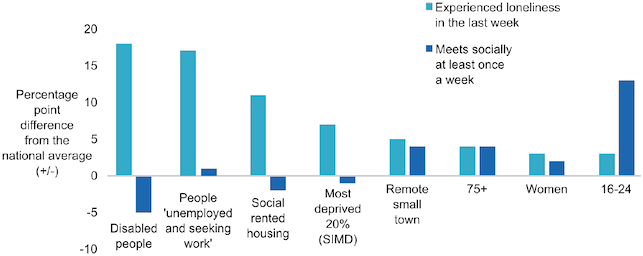
Other groups (disabled people, people in socially rented housing and people in more deprived areas) have higher levels of loneliness and lower levels of social interaction. This suggests a complex association between people’s circumstances, their connections with other people their mental wellbeing, and their experience of loneliness.
Case study stories for this research help to illustrate how the design of services and communities can have an excluding effect, and create mental health problems as a consequence of inappropriately designed or inaccessible services (Fig 8). However, we also know that local services, designed around a well-developed understanding of needs, can support social connections and be beneficial in improving people’s wellbeing and quality of life.[3]
(Fig 8. Excerpt from ‘Kay’s story’)
“You are asking local people to take a level of involvement that many people are incapable of and they are incapable not because they are stupid, not because they have no capacity to read and understand but because what is going on in their lives is taking all that they have. For some people the actual distress of being ill, or living in poverty, for instance, it just takes up so much energy. Which means that those voices are missing. This is not a mental illness that I have but the circumstances that I am in create a mental health burden and you then find yourself reading websites about anxiety and being offered anti-depressants and it is not appropriate but that is where you end up. It's hard to get people to believe in complex solutions. People like straight forward projects but it's all messier and smaller than that.”
Amenities and social infrastructure
The Scottish Household Survey asks respondents about the qualities of their neighbourhood and community. The factors that are rated most highly are the ‘people’ elements of neighbourhoods, for example the help, support, kindness, trust and friendship between neighbours, friends and community members.
At a national level, and across subgroups of the population, survey respondents are consistently more positive about the people aspects of their neighbourhoods and communities than the places and spaces available for social interaction and meeting new people (Fig 9).
Fig 9. People are more positive about the ‘people’ elements of their neighbourhoods than about the places and spaces available for social interaction.
- I could rely on a neighbour to help 86%
- People are kind to each other 83%
- People can be trusted 78%
- I would help my neighbours 91%
- There are places to meet and socialise 59%
- There are welcoming places to meet new people 53%
(% agreeing with statements, Scottish Household Survey, 2018)
This effect is even more pronounced in areas of higher deprivation (as shown in Fig 10), which suggests that there may be an unequal and insufficient level of provision for the places and spaces that create opportunities for social interaction. These spaces will be particularly important where the price of using commercial spaces such as cafes or restaurants may be unaffordable; and domestic spaces in homes may be unsuited for social interactions.
Fig 10. The availability of places to meet across different groups. The proportion of people who agree there are places to meet up and socialise in their neighbourhood is lower for people in social rented housing, areas of higher deprivation and people living in ‘other’ urban areas (areas with 10,000-124,999 people) .
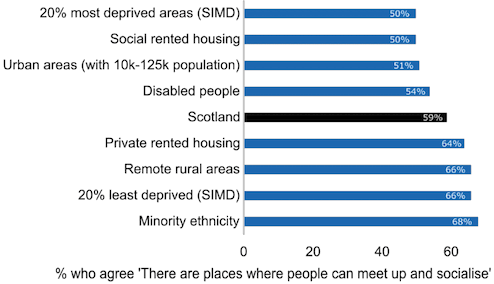
Engagement with decision making bodies
The Scottish Household Survey asks about the means that people have to influence and improve their local area – including through undertaking voluntary activities, and through more official decision making channels.
Although the voluntary dimension is strong - 58% of survey respondents said people take action to improve their local neighbourhood - access to decision making seems more remote, and just 20% of people said they feel they can influence decisions in their local area. These low levels of perceived influence on decision making are present across all sub-groups of the population, even the groups with higher levels of voluntary action to improve neighbourhoods (as shown in Fig 11).
Fig 11. Formal and informal means to improve neighbourhoods, by groups. Although there are different perceived levels of voluntary activities to improve neighbourhoods, there are low levels of perceived influence across all subgroups of the population.
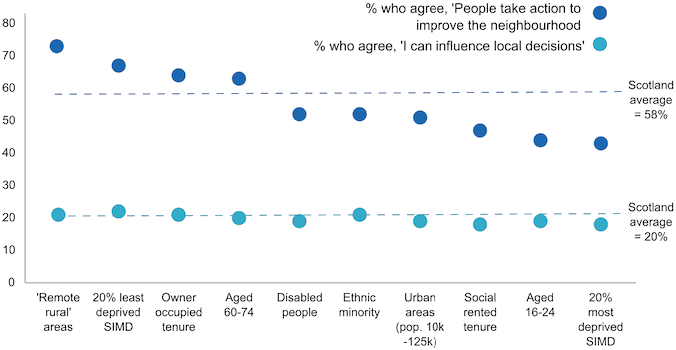
Priorities for increasing social capital
The findings suggest that the following points are important for improving social connections and social capital in communities.
1. Policymakers and practitioners in a wide range of policy settings would benefit from a better understanding of how their work affects social relationships and wellbeing in neighbourhoods and communities. Social connections are an essential element of personal, community and societal wellbeing and as shown in this report, they are influenced by a range of environmental, social and economic factors. To improve social connections, people involved in the design and delivery of public policy (for example, in the policy and practice settings mentioned in this report: social care, public transport, urban planning, community safety, housing, employment, economic planning, procurement and local democracy), need to consider not only how to achieve their own direct policy objectives, but also how to ensure that the other (possibly diffuse) consequences of their actions can create, sustain (and not damage) opportunities for social connections in communities.
2. We need to prioritise the places and groups that have the lowest levels of connections. The National Performance Framework refers to ‘all of our people’ in Scotland and outcomes depend not simply on a net gain in social capital at a national level (which could be achieved through improved social capital in already privileged groups), but on increasing social capital across all places, and subgroups of the population.
3. We need to ensure there are good quality, affordable and accessible places and spaces where people spend time, gather and meet. It is essential to create, retain and maintain the environmental and social infrastructure that supports social interactions and participation in communities – the informal public places, spaces, and facilities where people spend time, gather and meet. Evidence shows this is most important in the areas where there is a perceived lack of these places, e.g. in areas of deprivation and for disabled people.
4. People need to be involved more strongly in decisions about their communities. Levels of perceived influence over local decision making have been consistently low over recent years, and across all subgroups of the population. New and culturally deeper initiatives are required to enable people to have a greater influence over local decision making.
5. We need to base our understandings of community wellbeing on fuller and more rounded accounts than statistics alone can provide. A plural and multidimensional approach to understanding and measuring social capital, for example through multi-measurement data-dashboards and qualitative research, helps to highlight the connections and interdependencies between important economic, social, personal and historical factors. Case study stories also provide a perspective rooted in lived experience that is not available through quantitative research alone.
Contact
Email: ben.cavanagh@gov.scot
There is a problem
Thanks for your feedback